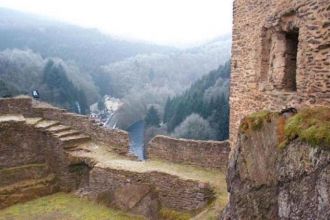
Luxembourg

City Rating by visitors:
0/5
Options
Destination rating view details
Automatically saved - thank you.
You can change your score!
Luxembourg Overview
The second-smallest member of the European Union and the third richest country of the world - the Grand Duchy of Luxembourg lies at the heart of Western Europe, at the crossroad of Germanic and Latin cultures. Bordered by Germany, France and Belgium, the whole country has population just about 500,000 people. Most of the inhabitants lives in Luxembourg city with its population around 100,000. Currently the country is a prominent financial and steel industry centre and enjoys a very high standard of living.
Read more about Luxembourg
Luxembourg has 3 officials languages – French, which is used among politicians and it´s preferred language of the governament, German – it´s language mostly used by businessman and Luxembourgish, which is considered as the national language of the Grand Duchy.
History of Luxembourg dates back to the year 963, when, due to its strategic position at the crossroad of Western Europe, the heavily fortified castle was built (today Luxembourg Castle). Later, around the fort was built and developed a town. In the 15th century, due to lack of male heir to assume the throne, the territory was sold by Duchess Elisabeth (Elisabeth was the only daughter and heiress of John of Görlitz, the third son of Charles IV, Holy Roman Emperor) to Philip the Good, duke of Burgundy. The neutrality of the country was violated by Germany in 1914 and it was liberated in September 1944. The current head of the state is the Grand Duke Henri I. de Luxembourg.
Luxembourg is a founding member of the United Nations and NATO and became one of the countries founding European Union in 1993. In 1999 the country joined euro currency area (Eurozone).
The city has developed into a banking and administrative center and it was place first for personal safety. Luxembourg is also a seat of several institutions of the European Union (including the European Court of Justice, the European Court of Auditors, the Secretariat of the European Parliament, the European Investment Bank, the European Investment Fund, and the European Stability Mechanism).
Luxembourgish cuisine is influenced on the cuisines of France, Belgium and Germany, recently it has been influenced by the many Italian and Portuguese immigrants. You can find there traditional delicacies as F´rell am Rèisleck (trout in Riesling sauce), Kriibsen (crayfish), the most traditional food is Judd mat Gaardebounen (smoked collar of pork with broad beans), as a desert you shouldn´t miss Verwurelter – small sugar coated doughnut or Äppelklatzen, all the food goes well with the traditional wine Moselle, which has a history dating back to the Romans.
Interesting places in Luxembourg city:
- Notre-Dame Cathedral of Luxembourg City and it´s the only one in the city. The cornerstone was laid in 1613 and it was elevated by Pope Pius IX.
- Grand Ducal Palace - the official residence of the Grand Duke of Luxembourg
- Fort Thüngen - the historic fortification, the original fortress was mainly damaged after the 1867. It has been reconstructed during the 1990s.
- Gëlle Fra (also known The Monument of Remembrance) – the war memorial of the city dedicated to the people who volunteered during the World War I.
- Mudam - the Grand Duke Jean Museum of Modern Art, designed by Pritzker-Prize winning architect I. M. Pei.
- Luxembourg City History Museum - it was founded in 1996 and illustrates the thousands-year history of the City of Luxembourg.
- Place d'Armes - the centrally placed square in the old town. It attracts many tourists and locals, especially during the summer time.
- Bocks Casemates - the 21 km long network of underground tunnels at the Bock rocky cliff.
Other points of interest located out of Luxembourg city:
- Esch-sur-Sûre Castle – a ruin located on a spur in the small town of Esch-sur-Sure in the north-west of Luxembourg. Originally a Romanesque tower from 927, which was enlarged in the Gothic style during the 13th century.
- Clervaux Castle – the castle from the 12th century, located on the northern Luxemburg (62 km out of the Luxembourg city centre).
- Vianden Castle - one of the largest fortified castles west of the Rhine, built between 10-14 century, located 45 km out of the Luxembourg city.
Maybe you didn´t know:
- The city was ranked as having the 2nd highest per capita GDP in the world.
- Mercer Quality of Living Survey - ranked Luxembourg 19th for quality of living.
- Luxembourg is the only enduring sovereign Grand Duchy in the world.
- The University of Luxembourg is the only university in the country.
- The main industries are iron and Steel, banking, food processing and chemicals.
- The country is on the list of the UNESCO World Heritage site because of its significant history in Roman.
Read less about Luxembourg ↑


Sights & culture
One of the most interesting attractions in Luxembourg, Bock Casemates, has the entrance at the Bock rocky cliff which is located...

Sights & culture
The Grand Ducal Palace is the official residence of the Grand Duke of Luxembourg. The Palace used to be the city hall from 1572 to...

Sights & culture
Located in the city centre on the main tourist square, its tall spires are very hard to miss. The Catholic Cathedral was built...

Sights & culture
Vinden Castle (built between the 11-14th century) rose like a phoenix from the ashes. Or in this case, more of a pile of stones...
Comments





























No one rated this. Be the first!